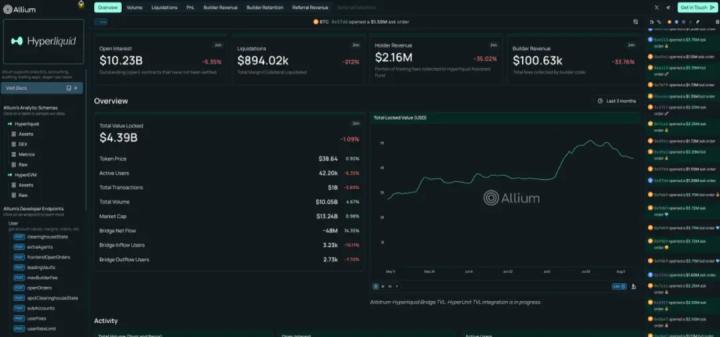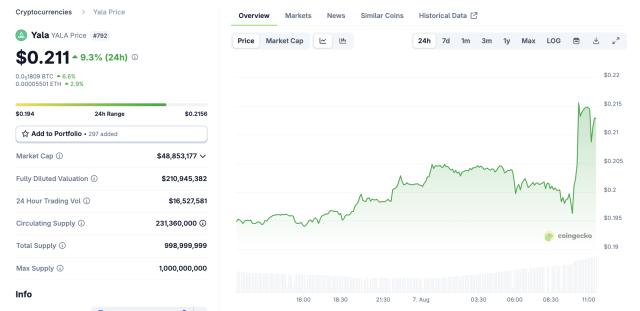Author: Zz, ChainCatcher
In early 2025, when the total locked value of the Hyperliquid ecosystem reached $2.36 billion, a deeper issue surfaced: According to DeFi Llama data, less than 5% of global crypto users have actually used DeFi protocols. The remaining 95% of potential users are kept out by complex operations, unfamiliar terminology, and learning costs.
The trillion-dollar DeFi market remains a game for a few technical elites. DreamCash wants to change this status quo.
Project Advantages and Innovation
When we deeply examine DreamCash's product logic, we discover an interesting phenomenon: it chose the most challenging but defensively strongest path - deeply binding to the Hyperliquid ecosystem.
DreamCash's core insight is: true DeFi popularization is not about creating more protocols, but about how to make the best existing infrastructure serve ordinary users. Facing traditional DeFi protocols that require users to understand complex concepts like Impermanent Loss, slippage, and MEV, most investors don't even understand basic terminology, let alone execute hedging strategies.
The reasons for choosing Hyperliquid are clear: sub-second latency, 200,000 order processing capacity per second, on-chain central limit order book (CLOB) architecture. This is not an ordinary blockchain, but a financial infrastructure born for high-frequency trading, providing performance guarantees for complex derivative transactions, with its native perpetual contract market offering ample liquidity and trading depth for automated strategies.
DreamCash's solution's core value is reflected in three breakthrough dimensions:
Experience: Traditional DeFi operations require mastering multiple protocol interfaces, while DreamCash enables one-click interaction on mobile, allowing users to configure strategies as simply as using Alipay.
Intelligence: Through an AI strategy engine that automatically executes complex trading decisions, using machine learning algorithms to analyze market data, smart contracts for automatic execution, and real-time risk control models, users can obtain expert-level strategy execution without being trading experts.
Threshold: Deep integration with the Hyperliquid ecosystem allows users to avoid learning complex DeFi knowledge, with a strict risk control system ensuring fund safety. Ordinary users now only need to download the APP to obtain institutional-level wealth management services.
More critically, DreamCash positions AI technology as an experience amplifier rather than a gimmick, perfectly aligning with the mature trend of the DeFAI (Decentralized Finance + Artificial Intelligence) track.
Early Progress and Market Positioning
Under the dual challenges of DeFi innovation slowdown and user growth stagnation, DreamCash's differentiated positioning appears particularly clear. The project targets an underestimated market: among 500 million global crypto users, only 10 million are active DeFi users - a gap of 490 million is its blue ocean market.
Behind this opportunity is the product advantage built by the team's unique genes. The founding team comes from traditional Web2 giants, deeply understanding the essence of user experience design. This "user-first" product philosophy gives DreamCash an experience DNA difficult for other technology-driven projects to replicate.
More worth noting is the deeper logic of its market strategy. DreamCash adopts an invitation-based cold start, creating early user stickiness through scarcity; its point reward system hints at future token airdrops, incentivizing community participation. This "experience first, then incentive" strategy is actually preheating for upcoming large-scale user acquisition.
Coinciding with the rising narrative of "DeFAI" in 2025, DreamCash clearly positions itself at the application layer, focusing on improving user experience with AI technology. Compared to infrastructure layer projects like Bittensor (market cap $2.9 billion) and Render ($1.6 billion), and protocol layer projects like Morpheus and SingularityNET, DreamCash directly serves end users, positioned at a critical value chain node.
DeFi Track, DreamCash's Differentiated Competition
When we zoom out to the entire DeFi ecosystem, we discover a clear differentiation trend: technological innovation is slowing down, and user experience is becoming the next battlefield.
Comparing global major competitors reveals obvious strategic differences: Uniswap focuses on protocol innovation but has a complex interface; 1INCH concentrates on aggregated trading but still has a high learning threshold; traditional wallets like MetaMask provide DeFi entry but lack revenue strategies. These products are powerful but cannot directly serve those 490 million "dormant" potential users.
DreamCash's uniqueness lies in its differentiated competition strategy:
- Relative to DeFi protocols, it is a traffic entry point rather than a competitor
- Relative to traditional wallets, it provides active revenue strategies beyond mere asset management
- Relative to centralized exchanges, it maintains the decentralized characteristic of on-chain custody
This strategy builds a bridge between professional DeFi and mass users.
Next Unicorn? DreamCash's Challenges and Possibilities
DreamCash's ambition is not just a tool. It's to make everyone a trader, to let everyone enjoy trader-level strategy execution.
But challenges are equally significant. Google Play user feedback shows regional restriction issues, lacking important emerging markets like India and Nigeria, which contradicts its "popularization" value proposition. User education costs remain high - even with the simplest packaging, retail users still need a learning process for concepts like "delta neutral".
Meanwhile, its deep dependence on Hyperliquid constitutes a systemic risk - if this 16-node network encounters security issues, DreamCash will be directly impacted. More subtly, Hyperliquid itself is developing frontend interfaces, potentially transforming from a partner to a competitor.
As traditional fintech giants like PayPal and Revolut accelerate Web3 deployment, and Coinbase redefines crypto trading through simplified experience, the boundaries of financial experience are melting. DreamCash stands at this crossroads. To the left, it might be trapped in Hyperliquid ecosystem limitations, becoming a niche tool for tech enthusiasts. To the right, it might become a super entry point connecting 490 million potential users with the DeFi world, redefining the user interface of decentralized finance.
As those 490 million "dormant" users reveal: DeFi's next growth wave won't come from more complex protocol innovations, but from simpler user experiences. What DreamCash is doing is picking up the key to awakening a trillion-dollar market.
(This article is for reference only and does not constitute investment advice)








